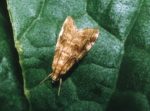Cabbage webworm
Hellula undalis ()
Lepidoptera: Pyralidae
Synonyms for Hellula undalis are Oebia undalis (), and Evergestis occidentalis .
Why is H. undalis difficult to control?
- attacks all plant growth stages
- one larva can destroy a plant
- larvae are protected in the growing point
Host plants and damage
Primary hosts: Brassicaceae (cruciferous crops), Brassica rapa (Pak-choi), Raphanus sativus (radish), Brassica oleracea var. capitata (cabbage)
Plant growth stages affected
Vegetative and flowering stages.
Affected plant parts
Larvae feed on the whole plant but are very destructive during by feeding at the growing point.
Symptoms
Young larvae mine leaves, bore stems and feed externally on the leaves. Larvae often destroy the terminal bud which results in plant death. While feeding they spin a silken tube.
Morphology & biology

Up to 300 eggs are laid on host plant leaves, prefferable near leaf veins.
Larvae have dark brown or black heads. The prothoracic plate is pale brown with a small dark spot on the lateral margins and two spots on the posterior margin.
The body is creamy white with light pinkish-brown longitudinal stripes. When fully grown, larvae are 12-15 mm in length
The pupae are contained within a loose cocoon in which are combined particles of soil and other matter.
Adults are greyish-brown with pale dusky hindwings. Each forewing has a prominent black spot and zigzagging, light brown lines. The central band between the lines is sometimes filled with darker brown scales. The length of the wings is 12.50 ± 0.48 mm in males and 14.55 ± 0.76 mm in females.

Monitoring
First instars are difficult to detect because they mine leaves. Look for later instars at the growing point of the plant. Larvae hide there and spin often a silken tube. Plants can be destroyed by a single larvae feeding at the terminal bud
Pest management
H. undalis frequently occurs in the same areas where the diamondback moth [Plutella xyolestella] is regarded as a major pest of Cruciferae. This complicates control measures directed to H. undalis, since measures used to control P. xylostella may adversely affect measures used to control H. undalis.
Cultural control
By rotating non-crucifers with crucifers, crop damage from H. undalis can be reduced. Transplanting and using nets to protect young plants in a nursery makes it more difficult for later instars to penetrate plant growing points.
Chemical Control

By feeding on the growing point, larvae are enclosed by young developing leaves. Control with chemicals is difficult therefore, because larvae are shielded from contact with insecticides. To achieve efficient chemical control, insecticides must be applied to the center of the plant. The action level for insecticides is very low because a single larva can destroy a plant.
Management of crucifers for cabbage webworm is simultaneously simple and complex. It is simple in that few options exist other than use of insecticides at crop emergence and thereafter, if risk of infestation persists. It is complex in that environment:pest interactions are not understood; consequently, risk of infestation cannot be predicted. By assuming that high risk of infestation exists with each crop, insecticides are applied when unwarranted; yet, if one assumes that the risk is low when it is not, damage from infestation is rapid and devestating.
Best practice is to treat crucifers with an effective insecticide immediately upon plant emergence. Thereafter, monitor for presence of larvae in plant growing points and on leaves. If a single, active larva is found continue to apply insecticides. Remember to alternate with ingredients that have different modes of action and refrain from mixing insecticides.
Recommendations for better management:
- low action threshold
- one spray within a week of plant emergence
- apply insecticides to the growing point
- grow plants in a protected nursery under net and then transplant